
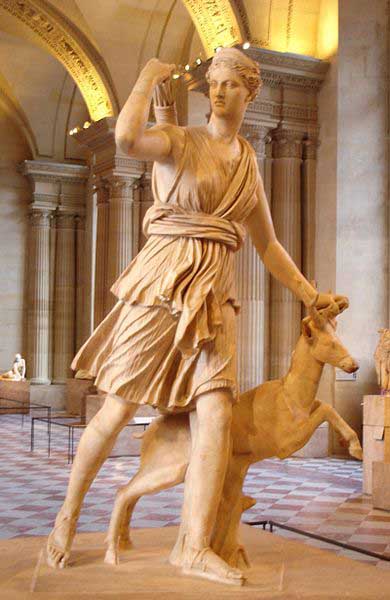


Artemis was one of the most widely venerated of the Ancient Greek deities. Her Roman equivalent is Diana. Some scholars believe that the name and indeed the goddess herself was originally pre-Greek. Homer refers to her as Artemis Agrotera, Potnia Theron: "Artemis of the wildland, Mistress of Animals". The Arcadians believed she was the daughter of Demeter.
In the classical period of Greek mythology, Artemis was often described as the daughter of Zeus and Leto, and the twin sister of Apollo. She was the Hellenic goddess of the hunt, wild animals, wilderness, childbirth, virginity and protector of young girls, bringing and relieving disease in women; she often was depicted as a huntress carrying a bow and arrows. The deer and the cypress were sacred to her.
She was the virgin moon goddess of the hunt, wild animals, healing, wilderness, chastity, and childbirth. She was worshipped as a fertility/childbirth goddess in many places since, according to some myths, she assisted her mother in the delivery of her twin.
At some point in the Classical period, she was identified by some with Hecate, the primal, pre-Olympian feral goddess. She much later became more identified with and eventually supplanted Selene as the moon goddess to complement her twin's identification with and supplantation of Helios as the sun god.
Artemis also assimilated Caryatis (Carya). Her priestesses were addressed with the title Melissa, which means "bee".
Artemis was not worshipped heavily in much of mainland Greece. In Asia Minor, however, she was a principal deity. The city of Ephesus is probably the best known of the Asian centers of her worship, from the story in the Acts of the Apostles, where the Ephesian metalsmiths who feel threatened by Paul's preaching of the new faith, zealously riot in her defense, shouting "Great is Diana of the Ephesians!"
In Rome, she was heavily venerated at Mount Tifata near Capua and in holy forests (such as Aricia, Latium) Her high priest lived in Aricia; his position was passed to the person who was able to kill him with a bough, picked from a tree in the forest.
Festivals in honor of Artemis include Brauronia, held in Brauron and the festival of Artemis Orthia in Sparta.
Young girls were initiated into the cult of Artemis at puberty. However, before marrying (an event in which they had little say, and which occurred shortly after puberty), they were asked to lay all the accoutrements of virginity (toys, dolls, locks of their hair) on an altar to Artemis.
Diana was worshipped in a temple on the Aventine Hill where mainly lower-class citizens and slaves worshipped her. Slaves could ask for and receive asylum in her temples. She was worshipped at a festival on August 13. Her name may have come from diviana (the shining one). It is often presumed that defeated peoples become a substratum beneath that of their conquerors. It seems plausible that the association of Diana worship with slaves may reflect the conquest of Goddess worshippers by, presumably, the early Romans.

As Agrotora, she was especially associated as the patron goddess of hunters. Artemis was often associated with the local Aeginian goddess, Aphaea. As Potnia Theron, she was the patron of wild animals; Homer used this title. As Kourotrophos, she was the nurse of youths. As Locheia, she was the goddess of childbirth and midwives. She was sometimes known as Cynthia, from her birthplace on Mount Cynthus on Delos. She sometimes used the name Phoebe, the feminine form of her brother, Apollo's, Phoebus.
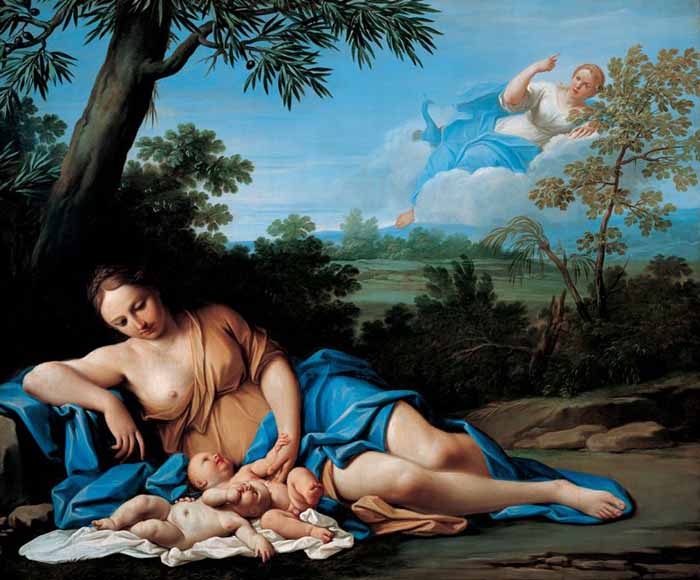
When Hera discovered that Leto was pregnant and that Hera's husband, Zeus, was the father, she banned Leto from giving birth on terra firma, or the mainland, or any island at sea. Leto found the floating island of Delos, which was neither mainland nor a real island and gave birth there. The island was surrounded by swans. As a gesture of gratitude, Delos was secured with four pillars. The island later became sacred to Apollo. Alternatively, Hera kidnapped Ilithyia, the goddess of childbirth, to prevent Leto from going into labour. The other gods forced Hera to let her go. Either way, Artemis was born first and then assisted with the birth of Apollo. Another version states that Artemis was born one day before Apollo, on the island of Ortygia and that she helped Leto cross the sea to Delos the next day to give birth to Apollo.
The childhood of Artemis is not fully related in any surviving myth. The Iliad reduced the figure of the dread goddess to that of a girl, who, having been thrashed by Hera, climbs weeping into the lap of Zeus. A poem of Callimachus to the goddess "who amuses herself on mountains with archery" imagines some charming vignettes: according to Callimachus, at three years old, Artemis, while sitting on the knee of her father, Zeus, asked him to grant her six wishes: to remain always a virgin; to have many names to set her apart from her brother Apollo; to be the Phaesporia or Light Bringer; to have a bow and arrow and a knee-length tunic so that she could hunt; to have sixty "daughters of Okeanos", all nine years of age, to be her choir; and for twenty Amnisides Nymphs as handmaidens to watch her dogs and bow while she rested. She wished for no city dedicated to her, but to rule the mountains, and for the ability to help women in the pains of childbirth.
Artemis believed that she had been chosen by the Fates to be a midwife, particularly since she had assisted her mother in the delivery of her twin brother, Apollo. All of her companions remained virgins, and Artemis closely guarded her own chastity. Her symbols included the golden bow and arrow, the hunting dog, the stag, and the moon. Callimachus tells how Artemis spent her girlhood seeking out the things that she would need to be a huntress, how she obtained her bow and arrows from the isle of Lipara, where Hephaestus and the Cyclops worked.
Okeanus' daughters were filled with fear, but the young Artemis bravely approached and asked for bow and arrows. Callimachus then tells how Artemis visited Pan, the god of the forest, who gave her seven bitches and six dogs. She then captured six golden-horned deer to pull her chariot. Artemis practiced with her bow first by shooting at trees and then at wild beasts.
As a virgin, Artemis had interested many gods and men, but only her hunting companion, Orion, won her heart. Orion was accidentally killed either by Artemis or by Gaia.
Alpheus, a river god, was in love with Artemis, but he realizes that he can do nothing to win her heart. So he decides to capture her. Artemis, who is with her companions at Letrenoi, goes to Alpheus, but, suspicious of his motives, she covers her face with mud so that the river god does not recognize her. In another story, Alphaeus tries to rape Artemis' attendant Arethusa. Artemis pities Arethusa and saves her by transforming Arethusa into a spring in Artemis' temple, Artemis Alphaea in Letrini, where the goddess and her attendant drink.
Bouphagos, the son of the Titan Iapetos, sees Artemis and thinks about raping her. Reading his sinful thoughts, Artemis strikes him at Mount Pholoe.
Sipriotes is a boy, who, either because he accidentally sees Artemis bathing or because he attempts to rape her, is turned into a girl by the goddess.
Multiple versions Actaeon myth survive, though many are fragmentary. The details vary but at the core they involve a great hunter, Actaeon who Artemis turns into a stag for a transgression and who is then killed by hunting dogs. Usually the dogs are his own, who no longer recognize their master. Sometimes they are Artemis' hounds.
According to the standard modern text on the work, Lamar Ronald Lacey's The Myth of Aktaion: Literary and Iconographic Studies, the most likely original version of the myth is that Actaeon was the hunting companion of the goddess who, seeing her naked in her sacred spring, attempts to force himself on her. For this hubris he is turned into a stag and devoured by his own hounds. However, in some surviving versions Actaeon is a stranger who happens upon her. Different tellings also diverge in the hunter's transgression, which is sometimes merely seeing the virgin goddess naked, sometimes boasting he is a better hunter than she, or even merely being a rival of Zeus for the affections of Semele.
She was once bathing nude in the woods when the Theban prince and hunter Actaeon stumbled across her. He stopped and stared, amazed at her ravishing beauty. He was so stunned that he accidentally stepped on a twig, and Artemis noticed him. She was so disgusted at his stares that she changed him to a stag and set his own hounds to kill him. He was torn apart by the deadly hunting dogs, who never knew that the stag they were hunting was their own master. Alternatively, Actaeon boasted that he was a better hunter than she and Artemis turned him into a stag and he was eaten by his hounds.
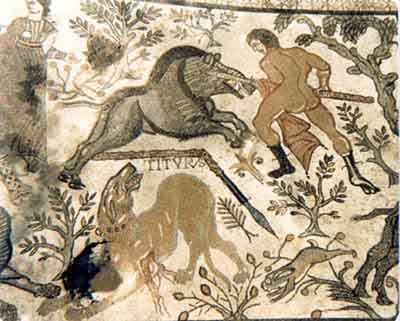
In some versions of the story of Adonis, who was a late addition to Greek mythology during the Hellenistic period, Artemis sent a wild boar to kill Adonis as punishment for his hubristic boast that he was a better hunter than she.
In other versions, Artemis killed Adonis for revenge. In later myths, Adonis had been related as a favorite of Aphrodite, and Aphrodite was responsible for the death of Hippolytus, who had been a favorite of Artemis. Therefore, Artemis killed Adonis to avenge HippolytusŐs death.
In yet another version, Adonis was not killed by Artemis, but by Ares, as punishment for being with Aphrodite.
A Cretan, Siproites, saw Artemis bathing nude and was changed by her into a woman. (The complete story does not survive in any mythographer's works, but is mentioned offhand by Antoninus Liberalis.)
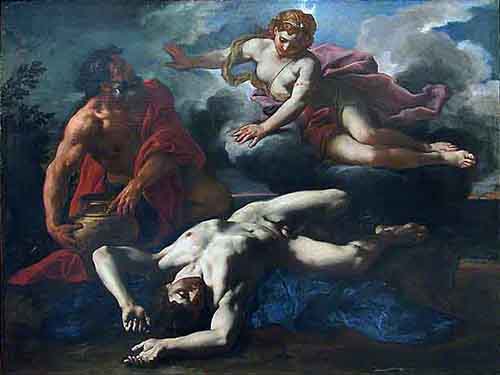
After leaving Eos, Orion became a follower of Artemis. She eventually killed him, though the reasons given vary.
Orion and Artemis were engaged. Her brother, Apollo didn't believe it was appropriate for her to marry a mortal. Apollo convinced Orion to walk out into the water and then dared Artemis to try to hit the barely visible speck (actually Orion's head) with an arrow from the shore. She succeeded, killing him.
Orion raped one of Artemis' female followers. She sent Scorpio, a scorpion, to kill him and both were placed in the stars as constellations. This legend explains why the constellation Scorpio rises just after Orion begins to set -- the scorpion still chases him. Orion's dog became Sirius, the dog-star.
Orion was Artemis' hunting companion. In some versions, he is killed by Artemis, while in others he is killed by a scorpion sent by Gaia. In some versions, Orion tries to seduce Opis, one of her followers, and she killed him.
In a version by Aratus, Orion took hold of Artemis' robe and she killed him in self-defense.
In yet another version, Apollo sends the scorpion. According to Hyginus Artemis once loved Orion (in spite of the late source, this version appears to be a rare remnant of her as the pre-Olympian goddess, who took consorts, as Eos did), but was tricked into killing him by her brother Apollo, who was "protective" of his sister's maidenhood.
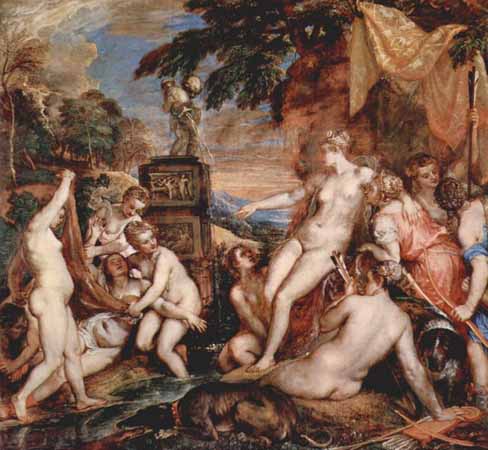
Callisto was the daughter of Lycaon, King of Arcadia and also was one of Artemis's hunting attendants. As a companion of Artemis, she took a vow of chastity. Zeus appeared to her disguised as Artemis, or in some stories Apollo, gained her confidence, then took advantage of her (or raped her, according to Ovid). As a result of this encounter she conceived a son, Arcas.
Enraged, Hera or Artemis (some accounts say both) changed her into a bear. Arcas almost killed the bear, but Zeus stopped him just in time. Out of pity, Zeus placed Callisto the bear into the heavens, thus the origin of Callisto the Bear as a constellation. Some stories say that he placed both Arcas and Callisto into the heavens as bears, forming the Ursa Minor and Ursa Major constellations.
Artemis punished Agamemnon after he killed a sacred stag in a sacred grove and boasted that he was a better hunter than the goddess. When the Greek fleet was preparing at Aulis to depart for Troy to begin the Trojan War, Artemis becalmed the winds. The seer Calchas advised Agamemnon that the only way to appease Artemis was to sacrifice his daughter Iphigenia. Artemis then snatched Iphigenia from the altar and substituted a deer. Various myths have been told around what happened after Artemis took her. Either she was brought to Tauros and led the priests there, or became Artemis' immortal companion.
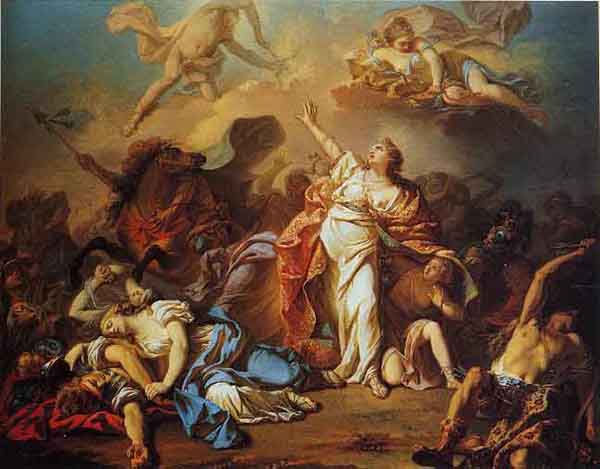
A Queen of Thebes and wife of Amphion, Niobe boasted of her superiority to Leto because while she had fourteen children (Niobids), seven boys and seven girls, Leto had only one of each. When Artemis and Apollo heard this impiety, Apollo killed her sons as they practiced athletics, and Artemis shot her daughters, who died instantly without a sound. Apollo and Artemis used poisoned arrows to kill them, though according to some versions two of the Niobids were spared, one boy and one girl. Amphion, at the sight of his dead sons, killed himself. A devastated Niobe and her remaining children were turned to stone by Artemis as they wept. The gods themselves entombed them.
Chione was a princess of Pokis. She was beloved by two gods, Hermes and Apollo, and boasted that she was prettier than Artemis because she made two gods fall in love with her at once. Artemis was furious and killed Chione with her arrow or struck her dumb by shooting off her tongue. However, some versions of this myth say Apollo and Hermes protected her from Artemis' wrath.
Zeus pursued Taygete, one of the Pleiades, who prayed to Artemis. The goddess turned Taygete into a doe but Zeus raped her when she was unconscious. She thus conceived Lacedaemon, the mythical founder of Sparta.
Otus and Ephialtes were a pair of brothers and giants. At one point, they wanted to storm Mt. Olympus. They managed to kidnap Ares and hold him in a jar for thirteen months. He was only released when Artemis offered to sleep with Otus. This made Ephialtes envious and the pair fought. Artemis changed herself into a doe and jumped between them. The Aloadae, not wanting her to get away, threw their spears and killed each other.
After the death of Meleager, Artemis turned her
grieving sisters, the Meleagrids into guineafowl.
Artemis saved the infant Atalanta from dying of exposure after her father abandoned her. She sent a female bear to suckle the baby, who was then raised by hunters. But she later sent a bear to hurt Atalanta because people said Atalanta was a better hunter. This is in some stories.
Among other adventures, Atalanta participated in the hunt for the Calydonian Boar, which Artemis had sent to destroy Calydon because King Oeneus had forgotten her at the harvest sacrifices. In the hunt, Atalanta drew the first blood, and was awarded the prize of the skin. She hung it in a sacred grove at Tegea as a dedication to Artemis.
Meleager was a hero of Aetolia. King Oeneus had him gather heroes from all over Greece to hunt the Calydonian Boar. After the death of Meleager, Artemis turned his grieving sisters, the Meleagrids into guineafowl that Artemis loved very much.
In Nonnus Dionysiaca, Aura was Greek goddess of breezes and cool air, daughter of Lelantos and Periboia. She was a virgin huntress, just like Artemis and proud of her maidenhood. One day, she claimed that the body of Artemis was too womanly and she doubted her virginity. Artemis asked Nemesis for help to avenge her dignity and caused the rape of Aura by Dionysus. Aura became a mad and dangerous killer. When she bore twin sons, she ate one of them while the other one, Iakhos, was saved by Artemis. Iakhos later became an attendant of Demeter and the leader of Eleusinian Mysteries.
Artemis may have been represented as a supporter of Troy because her brother Apollo was the patron god of the city and she herself was widely worshipped in western Anatolia in historical times. In the Iliad she came to blows with Hera, when the divine allies of the Greeks and Trojans engaged each other in conflict. Hera struck Artemis on the ears with her own quiver, causing the arrows to fall out. As Artemis fled crying to Zeus, Leto gathered up the bow and arrows.
Artemis played quite a large part in this war. Like her mother and brother, who was widely worshiped at Troy, Artemis took the side of the Trojans. At the Greek's journey to Troy, Artemis becalmed the sea and stopped the journey until an oracle came and said they could win the goddess' heart by sacrificing Iphigenia, Agamemnon's daughter. Agamemnon once promised the goddess he would sacrifice the dearest thing to him, which was Iphigenia, but broke the promise. Other sources said he boasted about his hunting ability and provoked the goddess' anger. Artemis saved Iphigenia because of her bravery. In some versions of the myth, Artemis made Iphigenia her attendant or turned her into Hecate, goddess of night, witchcraft, and the underworld.
Aeneas was helped by Artemis, Leto, and Apollo. Apollo found him wounded by Diomedes and lifted him to heaven. There, the three of them secretly healed him in a great chamber.
Artemis, the goddess of forests and hills, was worshipped throughout ancient Greece.Her best known cults were on the island of Delos (her birthplace); in Attica at Brauron and Mounikhia (near Piraeus); in Sparta. She was often depicted in paintings and statues in a forest setting, carrying a bow and arrows, and accompanied by a deer.
The ancient Spartans used to sacrifice to her as one of their patron goddesses before starting a new military campaign.
Athenian festivals in honor of Artemis included Elaphebolia, Mounikhia, Kharisteria, and Brauronia. The festival of Artemis Orthia was observed in Sparta.
Pre-pubescent and adolescent Athenian girls were sent to the sanctuary of Artemis at Brauron to serve the Goddess for one year. During this time, the girls were known as arktoi, or little she-bears. A myth explaining this servitude states that a bear had formed the habit of regularly visiting the town of Brauron, and the people there fed it, so that, over time, the bear became tame. A girl teased the bear, and, in some versions of the myth, it killed her, while, in other versions, it clawed out her eyes. Either way, the girl's brothers killed the bear, and Artemis was enraged. She demanded that young girls "act the bear" at her sanctuary in atonement for the bear's death.
Virginal Artemis was worshipped as a fertility/childbirth goddess in some places, assimilating Ilithyia, since, according to some myths, she assisted her mother in the delivery of her twin. During the Classical period in Athens, she was identified with Hecate. Artemis also assimilated Caryatis (Carya).
As Aeginaea, she was worshiped in Sparta; the name means either huntress of chamois, or the wielder of the javelin. She was worshipped at Naupactus as Aetole; in her temple in that town there was a statue of white marble representing her throwing a javelin. This "Aetolian Artemis" would not have been introduced at Naupactus, anciently a place of Ozolian Locris, until it was awarded to the Aetolians by Philip II of Macedon. Strabo records another precinct of "Aetolian Artemos" at the head of the Adriatic. As Agoraea she was the protector of the agora.
As Agrotera, she was especially associated as the patron goddess of hunters. In Elis she was worshiped as Alphaea. In Athens Artemis was often associated with the local Aeginian goddess, Aphaea. As Potnia Theron, she was the patron of wild animals; Homer used this title. As Kourotrophos, she was the nurse of youths. As Locheia, she was the goddess of childbirth and midwives. She was sometimes known as Cynthia, from her birthplace on Mount Cynthus on Delos, or Amarynthia from a festival in her honor originally held at Amarynthus in Euboea. She was sometimes identified by the name Phoebe, the feminine form of her brother Apollo's solar epithet Phoebus. In Sparta the Artemis Lygodesma was worshipped. This epithet means "willow-bound" from the Gr. lygos (willow) and desmos (bond). The willow tree appears in several ancient Greek myths and rituals.
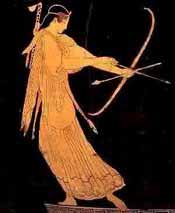
Many Neopagans, particularly Hellenistic sects in the United States, that worship Artemis today seem to omit many of the ancient myths. Those myths which are accepted by modern Neopagans seem to be interpreted rather abstractly, as mostly metaphor. Artemis is believed to be rather concerned with her follower's well being, but to reserve her boons to those who respect nature.
Artemis, in modern worship, is often seen as the goddess of wealth, magic, abundance, fertility, hunting, and longevity. While many who practice magic worship Hecate more favor Artemis for her supposed benevolence. Worship of Artemis may often include the burning of oils and incense, prayer, ritual nocturnal hunts, the burning of bread, and prostration. Artemis is thought to grant numerous boons and blessings on her followers, and is commonly worshipped by both men and women.
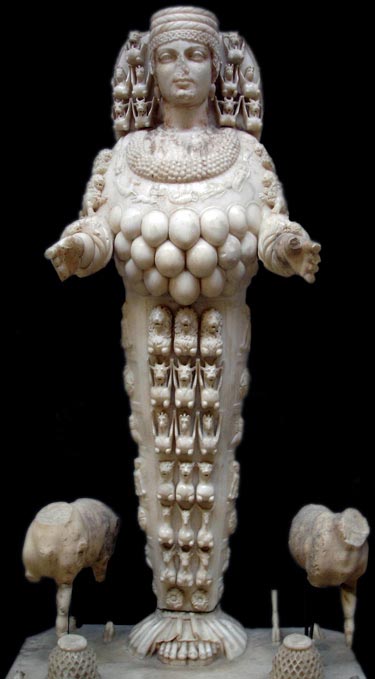
Artemis was born at the sixth day, the reason why it was sacred for her.
Festival of Artemis in Brauron, where girls, aged between five and ten, dressed in saffron robes and played the bear to appease the goddess after she sent the plague when her bear was killed.
Festival of Amarysia is a celebration to worship Artemis Amarysia in Attica.
In 2007, a team of Swiss and Greek archaeologists found the ruin of Artemis Amarysia Temple, at Euboea, Greece.
Festival of Artemis Saronia, a festival to celebrate Artemis in Trozeinos, a town in Argolis. A king named Saron built a sanctuary for the goddess after the goddess saved his life when he went on hunting and swept by the wave and held a festival for her.
At the 16 of Metageitnio (second month on Athenian calendar), people sacrifice to Artemis and Hecate at deme of Erchia.
Kharisteria Festival on 6 of Boidromion (third month) to celebrate the victory of Marathon and also known as the Athenian "Thanksgiving".
Day six of Elaphobolia (ninth month) festival of Artemis the Deer Huntress where she was offered cakes shaped like stags, made from dough, honey and sesame-seeds.
Day 6 of 16 of Mounikhion (tenth month) a celebration of her as the goddess of nature and animal. A goat was being sacrificed to her.
Day 6 of Thargelion (eleventh month) the 'birthday' of the goddess, while the seventh was Apollo's.
A festival for Artemis Diktynna (of the net) in Hypsous.
Laphria, a festival for Artemis in Patrai. The procession started by setting the logs of wood around the altar, each of them sixteen cubits long. On the altar, within the circle, is placed the driest of their wood. Just before the time of the festival, they construct a smooth ascent to the altar, piling earth upon the altar steps. The festival begins with a most splendid procession in honor of Artemis, and the maiden officiating as priestess rides last in the procession upon a chariot yoked to four deer, Artemis' traditional mode of transportation (see below). It is, however, not until the next day that the sacrifice is offered.
In Orchomenus, a sanctuary was built for Artemis Hymnia where her festival was celebrated every year.

Delos, Arcadia, Taurus, Sparta, Mount Taygete, Troezen, Hermione, Brauron, Ephesus, Crete, Sicily, Southern Italy Great Temple of Artemis at Mouth of Danube

In art, she was typically portrayed with a crescent moon above her head and her bow and arrows, created by Hephaestus and the Cyclopes. These arrows, in contrast to her role as goddess of childbirth, were said to be the cause of women dying in childbirth. Her brother Apollo exhibited contradiction as well, as he was a god of healing who brought leprosy, rabies and gout.
In Ephesus, the Temple of Artemis became one of the Seven Wonders of the World. In Ephesus, and elsewhere in Asia Minor, she was worshipped primarily as an Earth and fertility goddess, akin to Cybele, in mainland Greece. Statues in Greece depict her with her bow and arrow. In Asia Minor, she was often depicted with multiple rounded protuberances on her chest. They were formerly believed to be multiple breasts but are now known to have represented bull testes. Artemis